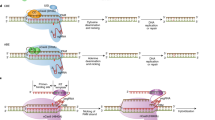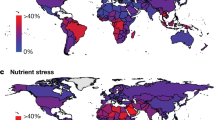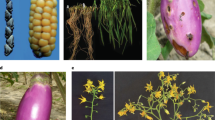Abstract
The costs of meeting regulatory requirements and market restrictions guided by regulatory criteria are substantial impediments to the commercialization of transgenic crops. Although a cautious approach may have been prudent initially, we argue that some regulatory requirements can now be modified to reduce costs and uncertainty without compromising safety. Long-accepted plant breeding methods for incorporating new diversity into crop varieties, experience from two decades of research on and commercialization of transgenic crops, and expanding knowledge of plant genome structure and dynamics all indicate that if a gene or trait is safe, the genetic engineering process itself presents little potential for unexpected consequences that would not be identified or eliminated in the variety development process before commercialization. We propose that as in conventional breeding, regulatory emphasis should be on phenotypic rather than genomic characteristics once a gene or trait has been shown to be safe.
This is a preview of subscription content, access via your institution
Access options
Subscribe to this journal
Receive 12 print issues and online access
$209.00 per year
only $17.42 per issue
Buy this article
- Purchase on Springer Link
- Instant access to full article PDF
Prices may be subject to local taxes which are calculated during checkout
Similar content being viewed by others
References
James, C. Preview: Global Status of Commercialized Biotech/GM Crops: 2004 (The International Service for the Acquisition of Agri-biotech Applications, ISAAA Briefs No. 32, 2004). http://www.isaaa.org
Kalaitzandonakes, N. Another look at biotech regulation. Regulation 27, 44–50 (2004).
Redenbaugh, K. & McHughen, A. Regulatory challenges reduce opportunities for horticultural biotechnology. Calif. Agric. 58, 106–119 (2004).
Pew Initiative on Food and Biotechnology. Issues in the Regulation of Genetically Engineered Plants and Animals (Washington, DC, 2004). http://pewagbiotech.org/research/regulation/Regulation.pdf
Pew Initiative on Food and Biotechnology. Impacts of Biotech Regulation on Small Business and University Research: Possible Barriers and Potential Solutions (Washington, DC, 2004). http://pewagbiotech.org/events/0602/proceedings.pdf.
Clearfield Production System (BASF Corporation, Research Triangle Park, NC, 2003). http://www.clearfieldsystem.com.
McElroy, D. Sustaining biotechnology through lean times. Nat. Biotechnol. 21, 996–1002 (2003).
Kalaitzandonakes, N. Strategies and structure in the emerging global seed industry. Biofutur 215, 38–42 (2001).
Economic Research Service. Farm income and costs: 2003 farm income estimates (Washington, DC, 2003). http://www.ers.usda.gov/Briefing/FarmIncome/2003incomeaccounts.htm
Gianessi, L. Biotechnology expands pest-management options for horticulture. Calif. Agric. 58, 94–95 (2004).
Clark, D., Klee, H. & Dandekar, A. Despite benefits, commercialization of transgenic horticultural crops lags. Calif. Agric. 58, 89–98 (2004).
James, J.S. Consumer knowledge and acceptance of agricultural biotechnology vary. Calif. Agric. 58, 99–105 (2004).
Graff, G.D., Wright, B.D., Bennett, A.B. & Zilberman, D. Access to intellectual property is a major obstacle to developing transgenic horticultural crops. Calif. Agric. 58, 120–126 (2004).
Jaffe, G. Withering on the Vine: Will Agricultural Biotech's Promises Bear Fruit? (Center for Science in the Public Interest, Washington, DC, 2005). http://cspinet.org/new/pdf/withering_on_the_vine.pdf.
Miller, H.I. & Conko, G. The Frankenfood Myth: How Protest and Politics Threaten the Biotech Revolution (Praeger Publishers, Westport, CT, 2004).
Barton, J. Crandon, J., Kennedy, D. & Miller, H. A model protocol to assess the risks of agricultural introductions. Nat. Biotechnol. 15, 845–848 (1997).
Strauss, S.H. Regulation of biotechnology as though gene function mattered. BioScience 53, 453–454 (2003).
Strauss, S.H. Genomics, genetic engineering, and domestication of crops. Science 300, 61–62 (2003).
Strauss, S.H., Merkle, S. & Parrott, W. Comments on proposed revisions to USDA regulations - 7 C.F.R. PART 340. Environmental Impact Statement; Introduction of Genetically Engineered Organisms. http://www.cropsoil.uga.edu/∼parrottlab/APHIS/index.htm
Federoff, N.V. & Brown, N.M. Mendel in the Kitchen. A Scientist's View of Genetically Modified Foods (Joseph Henry Press, Washington, DC, 2004).
National Research Council. Field-Testing Genetically Modified Organisms: Framework for Decision (National Academy Press, Washington, DC, 1989).
National Research Council. Genetically Modified Pest-Protected Plants: Science and Regulation (National Academy Press, Washington, DC, 2000).
National Research Council. Environmental effects of transgenic plants. The scope and adequacy of regulation (National Academy Press, Washington, DC, 2002).
Office of Science and Technology Policy. Exercise of federal oversight within scope of statutory authority: planned introductions of biotechnology products into the environment. Federal Register 57, 6753–6762 (1992).
Harper, G., Hull, R., Lockhart, B. & Olszewski, N. Viral sequences integrated into plant genomes. Annu. Rev. Phytopathol. 40, 119–136 (2002).
Hardwick, N.V., Davies, J.M.L. & Wright, D.M. The incidence of three virus diseases of winter oilseed rape in England and Wales in the 1991/02 and 1992/93 growing season. Plant Path. 43, 1045–1049 (1994).
Ho, M.-W., Ryan, A. & Cummins, J. Cauliflower mosaic viral promoter—a recipe for disaster? Microb. Ecol. Health Dis. 11, 194–197 (1999).
Hodgson, J. Scientists avert new GMO crisis. Nat. Biotechnol. 18, 13 (2000).
Carrington, J.C. & Ambros, V. Role of microRNAs in plant and animal development. Science 301, 336–338 (2003).
Redenbaugh, K. et al. Safety Assessment of Genetically Engineered Fruits and Vegetables: A Case Study of the Flavr Savr Tomato (CRC Press, Inc., Boca Raton, FL, 1992).
Fuchs, R.L. et al. Safety assessment of the neomycin phosphotransferase II (NPTII) protein. Bio/Technology 11, 1543–1547 (1993).
Bennett, P.M. et al. An assessment of the risks associated with the use of antibiotic resistance genes in genetically modified plants: report of the Working Party of the British Society for Antimicrobial Chemotherapy. J. Antimicrob. Chemother. 53, 418–31 (2004).
Flavell, R.B., Dart, E., Fuchs, R.L. & Fraley, R.T. Selectable marker genes: safe for plants? Bio/Technology 10, 141–144 (1992).
FDA. Guidance for Industry: Use of Antibiotic Resistance Marker Genes in Transgenic Plants (US Food and Drug Administration, Center for Food Safety and Applied Nutrition, Office of Premarket Approval, College Park, MD, 1998).
Gilissen, L.J.W., Metz, P.L.J., Stiekema, W.J. & Nap, J.-P. Biosafety of E. coli β-glucuronidase (GUS) in plants. Transgen. Res. 7, 157–163 (1998).
Gonsalves, D. Control of papaya ringspot virus in papaya: a case study. Annu. Rev. Phytopath. 36, 415–437 (1998).
Richards, H.A. et al. Safety assessment of green fluorescent protein orally administered to weaned rats. J. Nutr. 133, 1909–1912 (2003).
Stewart, C.N. Jr. The utility of green fluorescent protein in transgenic plants. Plant Cell Rep. 20, 376–382 (2001).
National Research Council. Biological confinement of genetically engineered organisms (The National Academy Press, Washington, DC, 2004).
Alonso, J.M. et al. Genome-wide insertional mutagenesis of Arabidopsis thaliana. Science 301, 653–657 (2003).
Schubert, D. et al. Silencing in Arabidopsis T-DNA transformants: the predominant role of a gene-specific RNA sensing mechanism versus position effects. Plant Cell 16, 2561–2572 (2004).
van Harten, A.M. Mutation Breeding. Theory and Practical Applications (Cambridge University Press, Cambridge, UK, 1998).
National Research Council. Safety of Genetically Engineered Foods: Approaches to Assessing Unintended Health Effects (National Academies Press, Washington, DC, 2004). http://books.nap.edu/catalog/10977.html
Haslberger, A.G. Codex guidelines for GM foods include the analysis of unintended effects. Nat. Biotechnol. 21, 739–741 (2003).
Kuiper, H.A., Kleter, G.A., Noteborn, H.P.J.M. & Kok, E.J. Assessment of the food safety issues related to genetically modified foods. Plant J. 27, 503–528 (2001).
Ozcan, H., Levy, A.A. & Feldman, M. Allopolyploidy-induced rapid genome evolution in the wheat (Aegilops-Triticum) group. Plant Cell 13, 1735–1747 (2001).
Sakamato, T. & Matsuoka, M. Generating high-yielding varieties by genetic manipulation of plant architecture. Curr. Opin. Biotechnol. 15, 144–147 (2004).
Tanksley, S.D. The genetic, developmental, and molecular bases of fruit size and shape variation in tomato. Plant Cell 16, S181–S189 (2004).
Ho, J.Y. et al. The root-knot nematode resistance gene (Mi) in tomato: construction of a molecular linkage map and identification of dominant cDNA markers in resistant genotypes. Plant J. 2, 971–982 (1992).
Young, N.D. & Tanksley, S.D. RFLP analysis of the size of chromosomal segments retained around the Tm-2 locus of tomato during backcross breeding. Theor. Appl. Genet. 77, 353–359 (1989).
USDA. Guide for Preparing and Submitting a Petition for Genetically Engineered Plants (US Department of Agriculture, Washington, DC, 1996). http://www.aphis.usda.gov/brs/user.html#agro
Wilson, A., Latham, J. & Steinbrecher, R. Genome scrambling – myth or reality? Transformation-induced mutations in transgenic crop plants (EcoNexus, Brighton, UK, 2004).
Arumuganathan, K. & Earle, E.D. Nuclear DNA content of some important plant species. Plant Mol. Biol. Rep. 9, 208–219 (1991).
Fu, H.H. & Dooner, H.K. Intraspecific violation of genetic colinearity and its implications in maize. Proc. Natl. Acad. Sci. USA 99, 9573–9578 (2002).
Song, R. & Messing, J. Gene expression of a gene family in maize based on noncollinear haplotypes. Proc. Natl. Acad. Sci. USA 100, 9055–9060 (2003).
Graham, M.J., Nickell, C.D. & Rayburn, A.L. Relationship between genome size and maturity group in soybean. Theor. Appl. Genet. 88, 429–432 (1994).
Mukherjee, S. & Sharma, A.K. Intraspecific variation of nuclear DNA in Capsicum annuum L. Proc. Indian Acad. Sci. USA 100, 1–6 (1990).
Rayburn, A.L., Auger, J.A., Benzinger, E.A. & Hepburn, A.G. Detection of intraspecific DNA content variation in Zea mays L. by flow cytometry. J. Exp. Bot. 40, 1179–1183 (1989).
Ilic, K., San Miguel, P.J. & Bennetzen, J.L. A complex history of rearrangement in an orthologous region of the maize, sorghum, and rice genomes. Proc. Natl. Acad. Sci. USA 100, 12265–12270 (2003).
Song, R., Llaca, V. & Messing, J. Mosaic organization of orthologous sequences in grass genomes. Genome Res. 12, 1549–1555 (2003).
Ching, A. et al. SNP frequency, haplotype structure and linkage disequilibrium in elite maize inbred lines. BMC Genet. 3, 19 (2002).
Wessler, S.R. Plant transposable elements. A hard act to follow. Plant Physiol. 125, 149–151 (2001).
San Miguel, P., et al. Nested retrotransposons in the intergenic regions of the maize genome. Science 274, 765–768 (1996).
Ceccarelli, M., Giordani, T., Natali, L., Cavallini, A. & Cionini, P.G. Genome plasticity during seed germination in Festuca arundinacea. Theor. Appl. Genet. 94, 309–315 (1997).
Shirasu, K., Schulman, A.H., Lahaye, T. & Shulze-Lefert, P. A contiguous 66-kb barley DNA sequence provides evidence for reversible genome expansion. Genome Res. 10, 908–915 (2000).
Ellstrand, N.C. Dangerous Liaisons? When Cultivated Plants Mate with Their Wild Relatives (Johns Hopkins University Press, Baltimore, MD, 2003).
Hoa, T.T.C., Al-Babili, S., Potrykus, I. & Beyer, P. Golden indica and japonica rice lines amenable to deregulation. Plant Physiol. 133, 161–169 (2003).
Landsmann, J., van der Hoeven, C. & Dietz-Pfeilstter, A. Variability of organ-specific expression of reporter genes in transgenic plants. in Transgenic Organisms and Biosafety (eds. Schmidt, E.R. & Hankeln, T.) 223–230 (Springer-Verlag, Berlin, 1996).
Jain, S.M. Tissue culture-derived variation in crop improvement. Euphytica 118, 153–166 (2001).
Author information
Authors and Affiliations
Corresponding author
Ethics declarations
Competing interests
Bradford
Bradford holds no direct stock in companies that would benefit from a change in crop biotechnology regulation. He works for a land grant university that releases new crop varieties, and thus he or the University might benefit by increased grants or royalties associated with changes in regulations that would facilitate the release of GE varieties. He is the Director of the UC Davis Seed Biotechnology Center, which is supported in part by the California seed industry as a whole from funds collected on seeds sold in California and administered by the California Department of Food and Agriculture. Bradford himself receives no salary or remuneration from this source. Some members of the seed industry could benefit from facilitated release of GE varieties. Bradford has conducted collaborative research with commodity groups and with agricultural companies funded through a UC-sponsored Discovery Grant program. Some of these projects involve genetic engineering. The Western Regional Seed Physiology Research Group, a voluntary organization of seed companies, supports research in Bradford s lab on seed physiology and technology.
Van Deynze
Van Deynze works for a land grant university that releases new crop varieties, and thus he or the University might benefit by increased grants or royalties associated with changes in regulations that would facilitate the release of GE varieties. He is employed by the UC Davis Seed Biotechnology Center, which is supported in part by the California seed industry as a whole from funds collected on seeds sold in California and administered by the California Department of Food and Agriculture. Some members of the seed industry could benefit from facilitated release of GE varieties. Van Deynze has conducted collaborative research with commodity groups and with agricultural companies funded through a UC-sponsored Discovery Grant program. Some of these projects involve genetic engineering.
Gutterson
Gutterson is the Chief Operating Officer of Mendel Biotechnology, a privately-held agbiotech company founded in 1997. He also has stock options in Mendel. Mendel is a developer of gene technologies for the improvement of plant performance, and has licensed its technology to a number of companies who are working to incorporate that technology into new crop varieties. Gutterson and Mendel would benefit from a change in GE regulations that simplify and reduce the regulatory burden on the development of biotech traits.
Parrott
Parrott works for a land grant university that releases new crop varieties, and thus he or the University might benefit by increased grants or royalties associated with changes in regulations that would facilitate the release of GE varieties. He has in the past, and continues to receive, a small proportion of his research funding from crop biotechnology or agricultural companies that might benefit from a change in GE regulations.
Strauss
Strauss holds no direct stock in companies that would benefit from a change in crop biotechnology regulation. He also does not consult or sit in the boards of such companies. He has in the past, and continues to receive, a small proportion of his research funding from crop biotechnology or forestry companies that might benefit from a change in GE regulations. He works for a land grant university that releases new crop varieties, and thus he or the University might benefit by increased grants or royalties associated with changes in regulations that would facilitate the release of GE varieties.
Rights and permissions
About this article
Cite this article
Bradford, K., Van Deynze, A., Gutterson, N. et al. Regulating transgenic crops sensibly: lessons from plant breeding, biotechnology and genomics. Nat Biotechnol 23, 439–444 (2005). https://doi.org/10.1038/nbt1084
Published:
Issue Date:
DOI: https://doi.org/10.1038/nbt1084
This article is cited by
-
Gene editing in tree and clonal crops: progress and challenges
In Vitro Cellular & Developmental Biology - Plant (2021)
-
Regulatory policy on genetically modified breeding stack in key countries and the current status in Korea
Food Science and Biotechnology (2021)
-
Crop biotechnology and the future of food
Nature Food (2020)
-
Genomic and phenotypic analyses of six offspring of a genome-edited hornless bull
Nature Biotechnology (2020)
-
Proposed U.S. regulation of gene-edited food animals is not fit for purpose
npj Science of Food (2019)



